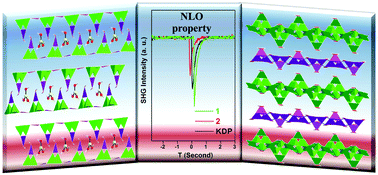Two deep-ultraviolet nonlinear optical alkaline-earth metal borates based on different types of oxoboron clusters†
Abstract
Two non-centrosymmetric alkaline-earth metal borates, Ca2[B5O8(OH)]2[B(OH)3]·H2O (1) and Ba2[B6O9(OH)2][B3O3(OH)4]·(OH)·4H2O (2), have been synthesized under solvothermal conditions. Both of them exhibit layered structures constructed from two fundamental building blocks (FBBs), respectively. 1 features porous double-layers made by the acentric single A-layer and B-layer in a face-to-face arrangement. Ca–O layers gather the B–O double-layers together resulting in the chiral structure of 1. Compound 2 contains two different FBBs, which is rare in borate. Hexaborate B6 clusters are responsible for the expansion of inorganic B6-layers while the isolated triborate B3 clusters are arranged in supermolecular B3-layers. Ba1-B6-layers and Ba2-B3-layers are alternately arranged in the same direction generating the NCS structure of 2. Both 1 and 2 are phase-matchable materials with second-harmonic generation (SHG) responses of ∼1.3 and ∼0.8 times that of KDP (KH2PO4), respectively. UV-vis diffuse reflectance spectra reveal that they have short cut-off edges lower than 200 nm. These characteristics make them potential deep-UV NLO materials. The calculations reveal that the SHG efficiency mainly originates from the synergistic effect of the distorted MOn (M = Ca, Ba; n = 7, 10, 11) polyhedra and the asymmetric π-conjugated of BO3 units.



 Please wait while we load your content...
Please wait while we load your content...